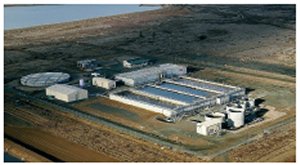Murray river town Echuca attains biogas re-use
Monday, 27 July, 2009
Recycling with water reclamation scheme
A combined effort from a number of suppliers has resulted in the successful operation of a water reclamation scheme at Echuca, on the Murray River, north of Bendigo.
The local water authority, Coliban Water, signed a 25-year agreement with Earth Tech to deliver a water reclamation plant, water storage and pipelines that would meet the needs of the area - the Campaspe Water Reclamation Scheme.

With sustainability as the driver, stage one of the scheme has achieved 100% water reclamation ending wastewater discharge to the Murray River. It also achieved 100% re-use of biosolids.
Local farmers can now access five million litres of high-quality class B water a day. The recycled water contains levels of phosphorus and nitrogen nutrients that provide further environmental benefits and cost savings from reduced fertiliser use.
“The project is more than just a treatment plant,” said Kay White, Senior Engineer (Process Design) for Earth Tech.
“It replaced the existing plant and developed a treatment system that involves biogas re-use and reduces greenhouse gases.”
CST Wastewater Solutions (then called Contra-Shear Technology) supplied the rotary fine screens that remove solids from the raw industrial and sewage wastewater.
“Our screens were used because they could get the fine removal solids down to 500 µm, which was an important pre-treatment step to ensure minimal fibre and solids passing into the anaerobic reactors,” said Michael Bambridge, Managing Director of CST Wastewater Solutions.
CST’s partner Global Water Engineering (GWE) supplied and installed the anaerobic plant coupled with biogas re-use.
According to the Naiad knowledge base of the Sustainable Water Sources Program, the reclamation plant treats mixed wastewater containing high organic loads from industry.
To cope with this high-strength influent, the plant uses upflow anaerobic sludge blanket (UASB) treatment, followed by extended aeration and sand filtration. The reclaimed water is disinfected using chlorine gas.
Reclaimed water is stored in two lined lagoons, from where it is delivered to farmers via a new distribution pipe network.
The recycled water, which complies with Victorian government guidelines, is mixed with existing channel water to achieve a salinity level suitable for irrigation.
Commenting on the biogas re-use, White said: “The UASB reduces organic matter, converting it to carbon dioxide, water and methane. The methane is burned to heat the UASB.”
The UASB is used only in the peak season, when the influent carries the biggest load.
“In Echuca, the annual tomato harvest, which lasts six weeks, produces a heavy organic load, so the wastewater requires full treatment. At other times, the UASB can be switched off when not needed,” she said.
According to Bambridge, “Anaerobic treatment of suitable wastewater streams has several main advantages, including low sludge production, a small footprint and being a net producer of energy instead of a large consumer.”
Researchers trial magnetic resin to remove PFAS
A magnetic resin invented at The University of Queensland will be trialled at wastewater...
A sustainable approach to increase wastewater recycling
Flinders University research is investigating improved effluent treatment and biosolids removal...
Inverell upgrades 30-year-old aeration system
The project entailed building a new tank at the Inverell Sewage Treatment Plant, to allow...








